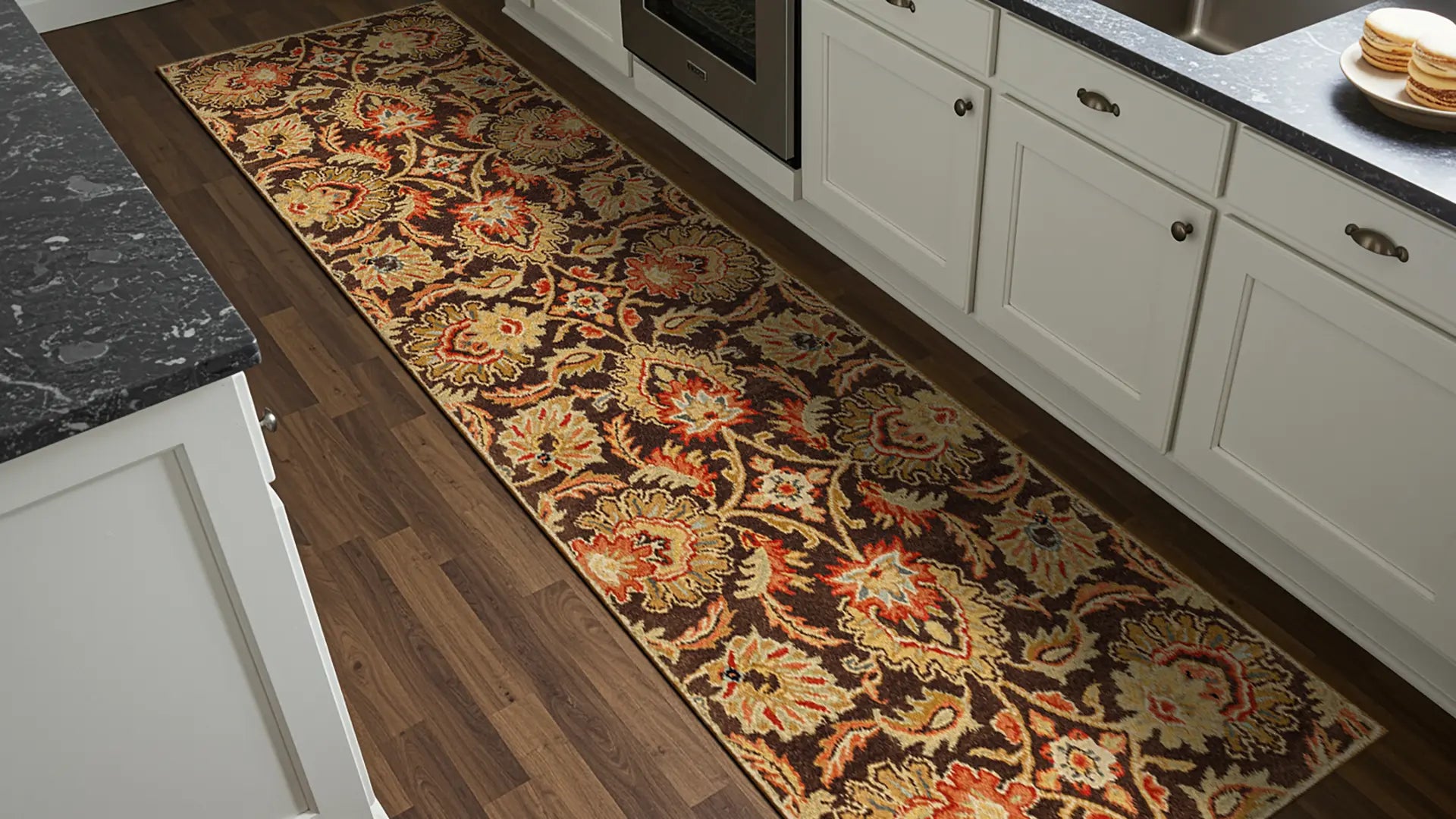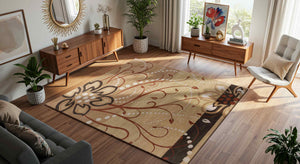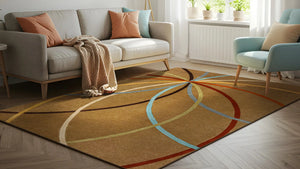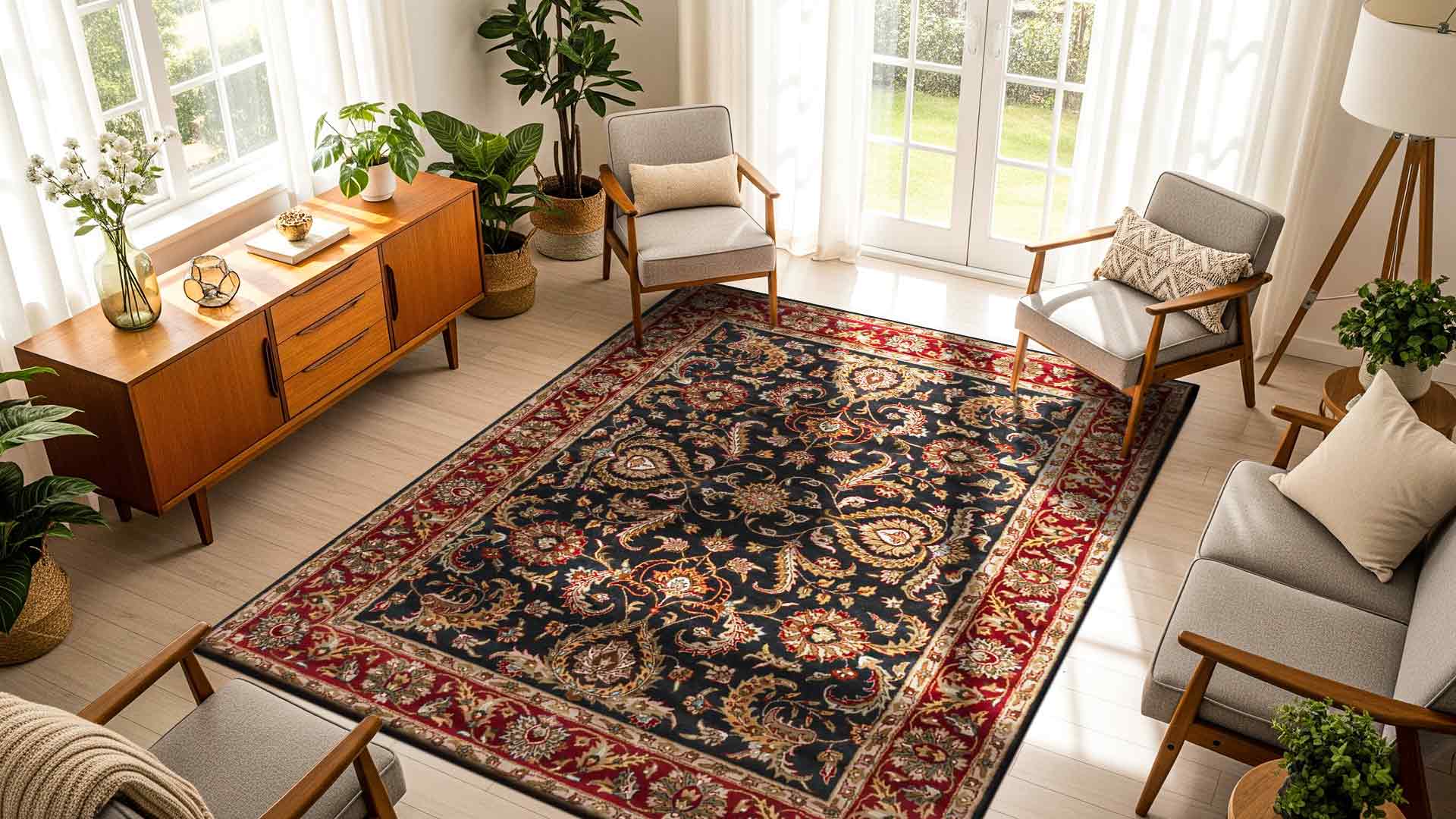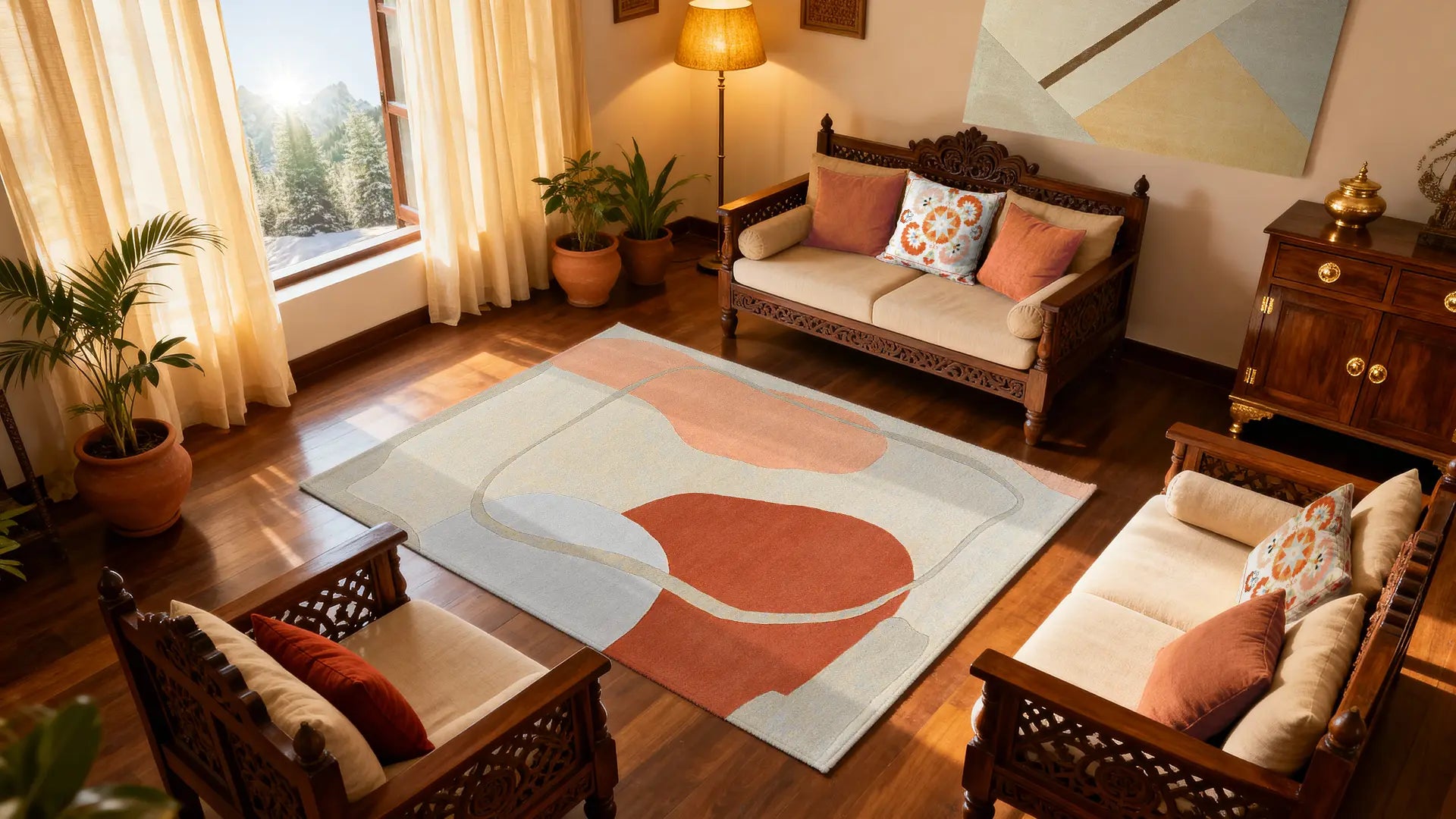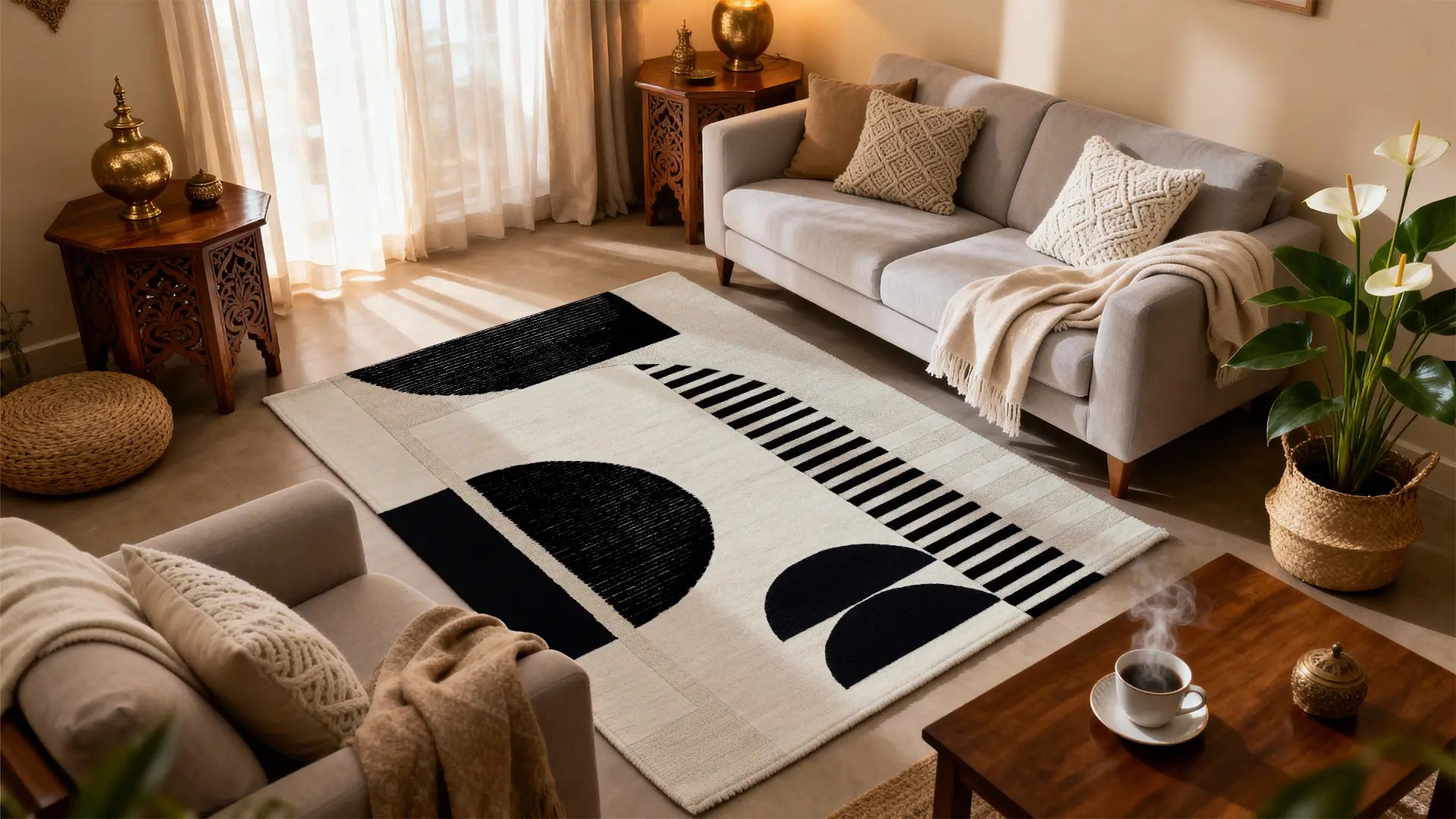Choosing theright rug for your kitchen is not just about looks. It’s also about making the space more functional, comfortable, and stylish. The kitchen rug helps define areas, adds warmth, and provides comfort in a busy part of the home. This guide will help you find a rug that meets your needs for design, durability, and practicality.
Why You Need a Rug in the Kitchen
Kitchens are busy places where comfort and function are important. Standing for long times while cooking or cleaning can cause sore feet and legs. A rug gives you the cushioning and support you need. Rugs also absorb noise, making the kitchen feel cozier. They protect floors from spills, scuffs, and scratches, especially near sinks, stoves, and food prep areas.
Besides being practical, a rug adds style, color, and warmth to the kitchen. It helps bring the overall look together, making the space feel complete. In open layouts, rugs can define different areas, like separating the cooking space from the dining area. For safety, especially in homes with kids or seniors, choose rugs with non-slip backing. A good kitchen rug combines style with comfort and safety, improving both the look and feel of your space.
Choosing the Right Rug Size for Your Kitchen
Finding the right rug size is as important as picking the right style or material. A well-sized rug adds comfort, defines your space, and ensures safe use in a busy kitchen.
Measure with Purpose
Before buying a rug, think about where it will go. Common places are: In front of the sink, Along a narrow kitchen, Under a kitchen island.
In the center of a large eat-in kitchen Use a measuring tape to get the right dimensions for your layout. Runner rugs, usually 2.5' x 7' or 2.5' x 10', are great for narrow, busy areas. For smaller spots like the sink, a 3' x 5' or 4' x 6' rug is perfect without taking up too much space.
Leave Breathing Room
To keep your kitchen looking neat, leave at least 6 inches of space between the rug’s edge and nearby cabinets or walls. This space prevents the rug from feeling cramped and makes cleaning around it easier. A little room also makes sure your rug looks well-placed, not squeezed into a tight spot.
Kitchen Rug Materials That Work: What to Choose and What to Skip
Choosing the right material for your kitchen rug is essential for durability, safety, and ease of maintenance. With frequent spills, foot traffic, and the need for quick cleaning, certain materials perform far better than others in this busy space.
Best Materials for Kitchen Rugs
1. Polypropylene: This synthetic fiber is a top pick for kitchens. It’s durable, stain-resistant, and affordable. Polypropylene rugs handle moisture well and are easy to clean, making them perfect for high-traffic, spill-prone areas.
2. Cotton: Cotton rugs are soft, lightweight, and machine washable. They work best in small areas like in front of the sink. While comfortable underfoot, they may need frequent washing to stay fresh.
3. Indoor-Outdoor Blends: Made from materials like recycled PET or other synthetics, these rugs are designed to withstand moisture and dirt. They're great for messy kitchen areas because they’re easy to hose down or wipe clean.
4. Nylon: Nylon rugs are tough and highly resistant to stains. They’re ideal for busy households, but they can be slippery on hard floors, so it’s best to pair them with a non-slip pad for safety.
5. Natural Fibers (Jute, Sisal): These eco-friendly options bring a warm, earthy texture to your kitchen. However, they’re not as easy to clean and can absorb moisture and odors. They’re better suited for low-use kitchen zones or decorative purposes.
Avoid High-Pile Rugs
High-pile or shag rugs might look plush, but they’re not practical for the kitchen. These rugs trap crumbs, moisture, and dirt, making them hard to maintain. Instead, choose low-pile or flatweave rugs—they’re easier to vacuum, spot-clean, and keep hygienic in a space where cleanliness is key.
Focus on Easy Maintenance
In a kitchen where spills and messes are part of daily life, choosing a rug that's easy to clean is key. Low-maintenance options not only save time but also keep your space looking fresh and functional with minimal effort.
Machine-Washable Rugs
Kitchen rugs need to be as hardworking as the people who use them. That’s why machine-washable rugs are a smart choice for busy households. Whether you’re dealing with food spills, muddy footprints, or pet accidents, these rugs can go straight into the washing machine for a hassle-free clean.
Ideal for families, pet owners, and avid home cooks, machine-washable rugs save time and reduce stress. Look for brands known for durability—rugs that hold their shape, color, and texture even after repeated washes. Many options feature low-pile designs that dry quickly and resist mildew, making them even more practical for kitchens.
Read Also: Top Reasons Why Carpets and Rugs Are a Must-Have for Your Home
Spot Cleaning and Stain Resistance
Even with a washable rug, quick spot cleaning is essential. Choose rugs made with stain-resistant treatments or those in dark colors and busy patterns to help disguise spills and stains. These features help maintain a clean look between deeper washes.
Blotting spills right away prevents liquids from setting in. Keep a mild cleaning solution—like diluted dish soap or vinegar and water—on hand for spot treatment. This allows you to quickly manage messes before they become permanent, keeping your rug and kitchen looking their best.
Rug Styles That Complement Your Kitchen Decor
Your kitchen rug should do more than protect your floor—it should also enhance your style. The right rug can bring warmth, color, and character that shows your personal taste. Whether your kitchen is modern or cozy, there’s a rug style for you.
Modern Minimalist Kitchens
In modern spaces, less is more. Solid colors or simple geometric patterns keep the look clean. Neutral shades like gray, black, beige, or white blend well with sleek cabinets and metal finishes. If you want a bolder look, consider using a monochrome rug. Choose a bright color, like deep blue or emerald. This will add contrast without being overwhelming.
Farmhouse or Rustic Kitchens
A vintage-style flatweave or distressed rug fits well in farmhouse kitchens. Choose classic patterns like stripes or faded florals in earthy tones such as terracotta, mustard, and navy. These colors match wood finishes and add a warm, homey feel. Look for rugs with a weathered look to boost the rustic charm.
Bohemian or Eclectic Kitchens
For playful or layered decor, choose colorful kilims, Moroccan-inspired prints, or layered rugs in bold colors. Patterns and textures are important here. Add interest with fringe, tassels, or multi-textured weaves that bring personality and global flair. This is your chance to mix and match freely.
Scandinavian Kitchens
Scandinavian design focuses on simplicity and natural beauty. Choose cotton or wool-blend runners in neutral shades like ivory, gray, or taupe. Clean lines and soft textures help keep a calm, minimalist vibe. These rugs go well with light wood, white walls, and open layouts common in Nordic kitchens.
Where to Place Rugs in the Kitchen for Comfort
Placing rugs in the right spots can make your kitchen more comfortable and appealing. A well-placed rug can reduce fatigue, protect your floors, and create clear zones. Here are the best spots for rugs.
Sink Area
This is the most common spot for a kitchen rug. A small rectangular rug or cushioned mat in front of the sink gives relief while washing dishes. It catches drips and protects your floor from water damage. Choose a washable, non-slip rug that lasts.
Under the Kitchen Island
If your kitchen has an island with stools, a rug underneath can anchor the space. It adds warmth and comfort, especially during meals. Make sure the rug is large enough for chairs to stay on it when pulled out—this prevents tripping.
Kitchen Runners
In galley kitchens or long layouts, runners are a great choice. They offer a cushioned path along high-use areas, like from the sink to the stove. Runner rugs also define walkways and connect different zones, adding flow to the space. Choose low-pile or flatweave runners for easy cleaning.
Color Psychology in the Kitchen: Pick the Right Hue
Color plays a powerful role in setting the mood of your kitchen. The rug you choose isn’t just a functional piece—it’s a visual anchor that can influence how the space feels and functions. Selecting the right hue can enhance your kitchen’s personality while supporting your overall design.
-
Blue: Known for its calming and cooling effect, blue creates a serene vibe in the kitchen. It works especially well in coastal or modern spaces, where it brings a clean, refreshing touch.
-
Red: A bold and energizing color, red is believed to stimulate appetite and add a sense of warmth. It’s a great fit for traditional or farmhouse kitchens that embrace cozy, welcoming tones.
-
Green: Associated with nature and renewal, green feels fresh and calming. It pairs beautifully with wood finishes and natural materials, making it ideal for rustic or organic design themes.
-
Gray or Black: These neutral tones are both sleek and practical. They blend easily with most color schemes while effectively hiding stains and wear, making them perfect for high-traffic kitchens.
-
Multi-colored: For eclectic or busy households, multi-colored rugs bring energy and flexibility. They hide dirt well and allow you to pull in accent colors from surrounding decor.
Read Also: 4 Crucial Factors to Check Before Buying a Handmade Rug
Top Mistakes to Avoid When Choosing a Kitchen Rug
Selecting the right kitchen rug involves more than just picking a pretty design. To make the most of your rug in this high-traffic area, avoid these common mistakes that can impact both function and appearance.
Choosing the wrong size: A rug that is too small will feel out of place. It will not protect the floor well. Make sure your rug fits the area. It should cover enough floor to hold furniture or cover where you stand most.
Ignoring safety features: Not using a non-slip backing or rug pad can be risky. This is especially true in rooms with hard floors and lots of movement. Always make sure your rug stays in place.
Opting for high-pile rugs: Plush or shag rugs may look cozy, but they’re not practical in kitchens. They trap crumbs, absorb spills, and are difficult to clean. Stick to low-pile or flatweave rugs for easy maintenance.
Picking light colors without stain protection: Light shades show every spill and splash. If you love a pale rug, choose one with a stain-resistant coating or washable fabric to make cleaning easier.
Not considering foot traffic: Think about how people move through your kitchen. Choose materials and placements that can withstand daily wear in high-traffic zones like the sink, stove, and prep areas.
Conclusion: The Right Rug Makes All the Difference
A kitchen rug does more than just look good—it brings comfort underfoot, helps prevent slips, and protects your floors from daily wear. When thoughtfully chosen, it becomes a practical and stylish addition that enhances the overall feel of your kitchen.
From choosing strong materials to finding the right size, making sure it’s easy to clean, and fitting your design style, every choice matters. Each decision helps make your kitchen more useful and welcoming. With the tips above, you can pick rugs and carpets that fit your space well. This will help create a kitchen that is both lovely and practical for daily use.


